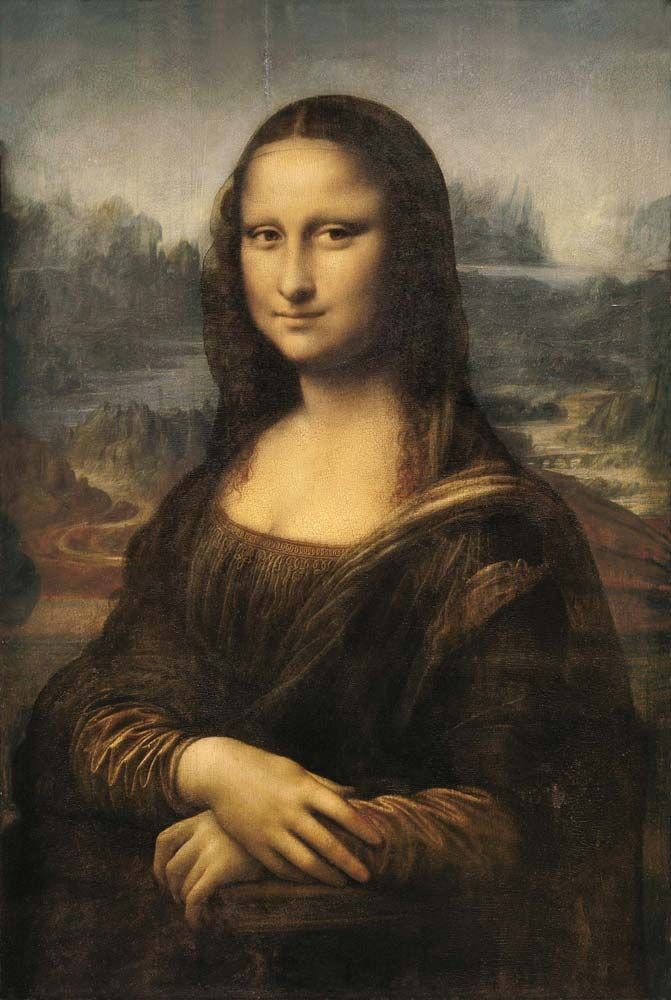The Mona Lisa, Leonardo da Vinci’s masterpiece from the early 16th century, stands as the world’s most recognizable and arguably most famous painting. Housed securely behind bulletproof glass in the Louvre Museum, it attracts throngs of visitors daily, all eager to catch a glimpse of this iconic artwork. Yet, for many, the painting itself, a modestly sized portrait of a seemingly ordinary woman, might appear underwhelming. Dressed in simple dark clothing and a veil, devoid of opulent jewelry, her famed smile and gaze often leave viewers pondering: what truly fuels this enduring fascination? While numerous theories attempt to pinpoint a singular reason for its celebrity, the reality is far more nuanced. The Mona Lisa’s fame is not attributable to one factor alone but rather a confluence of historical accidents and inherent artistic qualities that have, over centuries, conspired to create its unparalleled status.
 Mona Lisa, oil on wood panel by Leonardo da Vinci, c. 1503-06; in the Louvre, Paris, France. 77 x 53 cm.
Mona Lisa, oil on wood panel by Leonardo da Vinci, c. 1503-06; in the Louvre, Paris, France. 77 x 53 cm.
Artistic Brilliance and Innovation
Undeniably, the Mona Lisa is a remarkable work of art. Even during its creation, Leonardo’s contemporaries recognized its exceptional quality, evidenced by the numerous copies made of its revolutionary three-quarter pose. Giorgio Vasari, the renowned art historian, lauded Leonardo’s unparalleled ability to capture the essence of nature in his art. The Mona Lisa exemplifies this realism. Her softly modeled face showcases Leonardo’s mastery of sfumato, a groundbreaking technique employing subtle gradations of light and shadow to create depth and form, revealing his deep understanding of anatomy and underlying structure. The delicate rendering of the veil, the intricate details of her hair, and the meticulous depiction of fabric folds all testify to Leonardo’s profound observation skills and unwavering patience. Furthermore, while her enigmatic smile and steady gaze weren’t considered particularly mysterious until the 19th century, modern viewers are captivated by her ambiguous expression, recognizing in her a complexity that mirrors the intricacies of human nature itself.
The Louvre’s Legacy and Royal Pedigree
However, artistic merit alone doesn’t fully explain the Mona Lisa’s stratospheric fame. Countless masterpieces exist, yet few attain such global recognition. External factors have significantly amplified its renown, and chief among them is its home: the Louvre Museum. As one of the most visited museums globally, the Louvre provides an unparalleled stage for the Mona Lisa to be seen by millions each year. The painting’s journey to the Louvre itself is steeped in history, beginning with King Francis I of France, in whose court Leonardo spent his final years. Becoming part of the royal collection, the Mona Lisa resided in French palaces for centuries, largely secluded from public view until the French Revolution. The Revolution transformed the royal collection into public property, and after a brief period adorning Napoleon Bonaparte’s bedroom, the Mona Lisa was installed in the Louvre at the dawn of the 19th century. As the Louvre’s prestige and visitor numbers swelled, so too did the painting’s visibility and reputation.
The Intrigue of Identity and Romantic Mystique
The sitter’s identity further fueled the painting’s mystique. Although scholarly consensus points to Lisa Gherardini, the wife of Florentine merchant Francesco del Giocondo, definitive proof of this commission remains elusive. This ambiguity surrounding her identity has allowed for endless interpretations and projections onto the Mona Lisa figure. The 19th-century Romantic era particularly embraced this enigmatic aspect, transforming a likely Florentine housewife into a mysterious seductress in the popular imagination. French writer Théophile Gautier described her as a “strange being…her gaze promising unknown pleasures,” while others embellished her image with tales of perfidy and enchantment. Walter Pater, an English essayist, even famously characterized her as a vampire who “has been dead many times, and learned the secrets of the grave,” cementing the air of mystery that continues to enshroud the Mona Lisa and inspire speculation.
The Myth of Leonardo: Genius and Icon
Concurrently, the 19th century witnessed the elevation of Leonardo da Vinci to mythical genius status. While respected in the centuries following his death, he was initially considered on par with contemporaries like Michelangelo and Raphael. However, the 19th-century surge in Renaissance studies propelled Leonardo beyond mere painter status. He was reimagined as a visionary scientist and inventor, his sketches and designs seen as precursors to modern inventions. While many of these “inventions” were later debunked, and his scientific contributions reassessed as relatively minor, the myth of Leonardo as a universal genius persisted and flourished into the 21st century. This amplified perception of Leonardo’s genius naturally extended to his most famous creation, further enhancing the Mona Lisa’s allure and perceived importance.
The 1911 Theft: A Media Sensation
While 19th-century writers kindled public interest, the 1911 theft of the Mona Lisa and the ensuing media frenzy catapulted it to global superstardom. News of the audacious crime on August 22nd reverberated worldwide. People flocked to the Louvre, captivated by the empty space where the painting once hung. The museum director resigned, newspapers speculated on elaborate hoaxes, and even Pablo Picasso was briefly considered a suspect! Two years later, the painting resurfaced in Italy after a Florentine art dealer alerted authorities about a man attempting to sell it. The culprit was Vincenzo Peruggia, an Italian immigrant and former Louvre employee who had briefly worked on installing protective glass, including on the Mona Lisa. Peruggia, along with accomplices, had removed the painting, hidden it overnight within the museum, and absconded with it the following morning. Unable to sell it due to the intense media attention, Peruggia concealed it in a trunk until his capture. His trial and conviction, coupled with the painting’s triumphant return to the Louvre after a tour of Italy, solidified the Mona Lisa as a French national treasure, deeply embedding it in the collective consciousness.
Duchamp, Pop Art, and Mass Reproduction
The Mona Lisa’s fame undeniably escalated after the theft, but World War I shifted global attention. Some scholars argue that Marcel Duchamp’s provocative defacement of a Mona Lisa postcard in 1919 reignited public fascination and ushered in an era of popular culture appropriation. Duchamp playfully subverted the reverence for high art by adding a mustache and beard to the Mona Lisa and inscribing L.H.O.O.Q., a French pun with a vulgar connotation. This act of irreverence sparked a minor scandal and inspired other artists to recognize the attention-grabbing potential of such gestures. Artists like Andy Warhol further embraced this trend in subsequent decades, utilizing the Mona Lisa in pop art. As artists distorted, reinterpreted, and played with reproductions, cartoonists and advertisers further exaggerated and disseminated her image. Technological advancements in reproduction facilitated the Mona Lisa’s ubiquitous presence, making her face instantly recognizable even to those with minimal art interest.
Global Tours and Unprecedented Access
Tours to the United States in 1963 and Japan in 1974 elevated the Mona Lisa to true celebrity status. Traveling in first-class luxury aboard an ocean liner, the painting drew approximately 40,000 daily visitors at both the Metropolitan Museum in New York City and the National Gallery of Art in Washington, D.C., during its six-week American sojourn. Similar massive crowds greeted it in Japan a decade later. Furthermore, the increasing affordability of international travel since the late 20th century has enabled more and more individuals to visit Paris and witness the Mona Lisa firsthand, contributing to the persistent throngs of admirers at the Louvre today.
A Symphony of Circumstances
In conclusion, while the Mona Lisa’s artistic brilliance is undeniable, its unparalleled fame is not solely attributable to its inherent qualities. Instead, it is the result of a remarkable confluence of factors: its prominent placement in the Louvre, the romanticized mystery surrounding the sitter, the mythologization of Leonardo da Vinci, the sensational theft of 1911, its appropriation in popular culture, and its global tours. These disparate elements, intertwined with the painting’s intrinsic appeal, have collectively cemented the Mona Lisa’s position as the most famous painting in the world – a testament to how historical context and cultural narratives can amplify artistic achievement to create a truly global icon.
